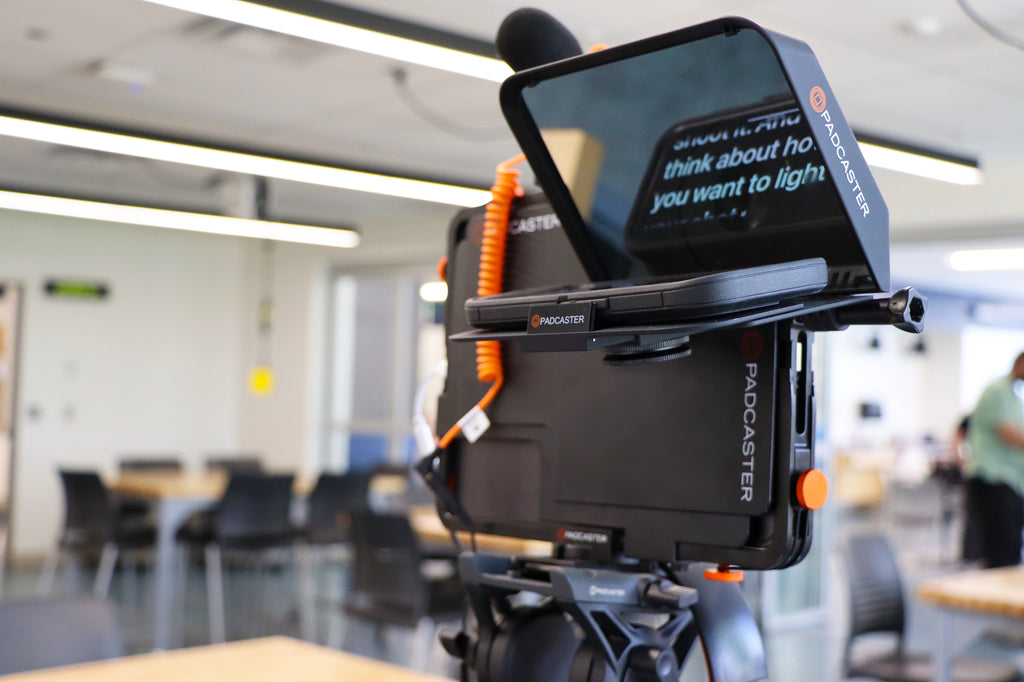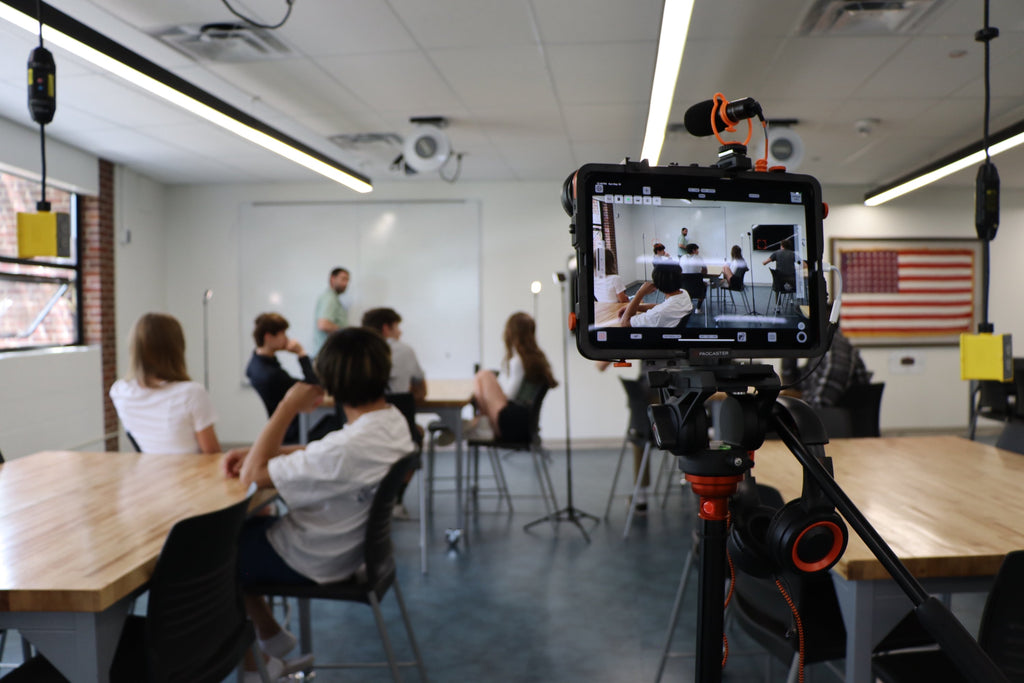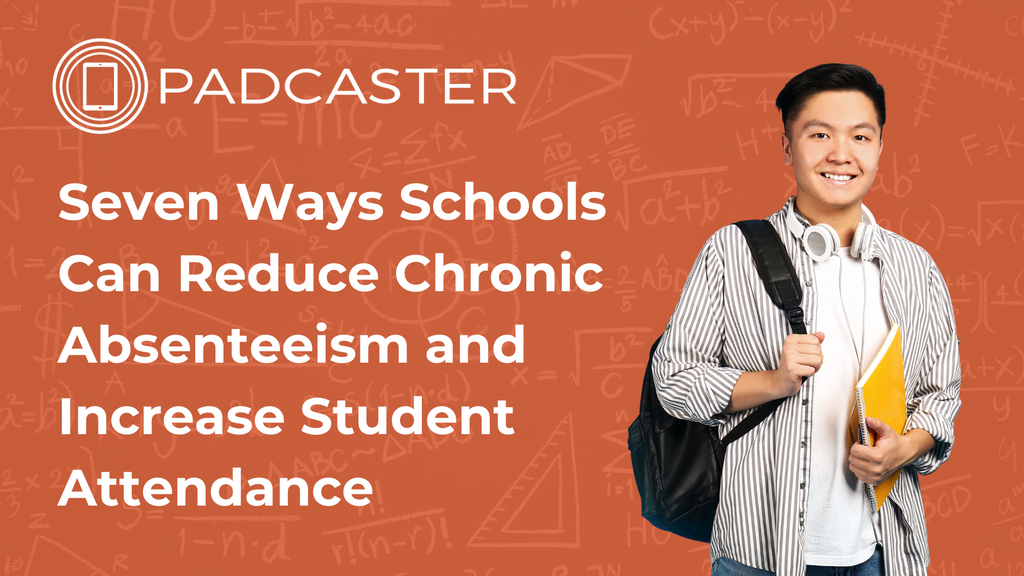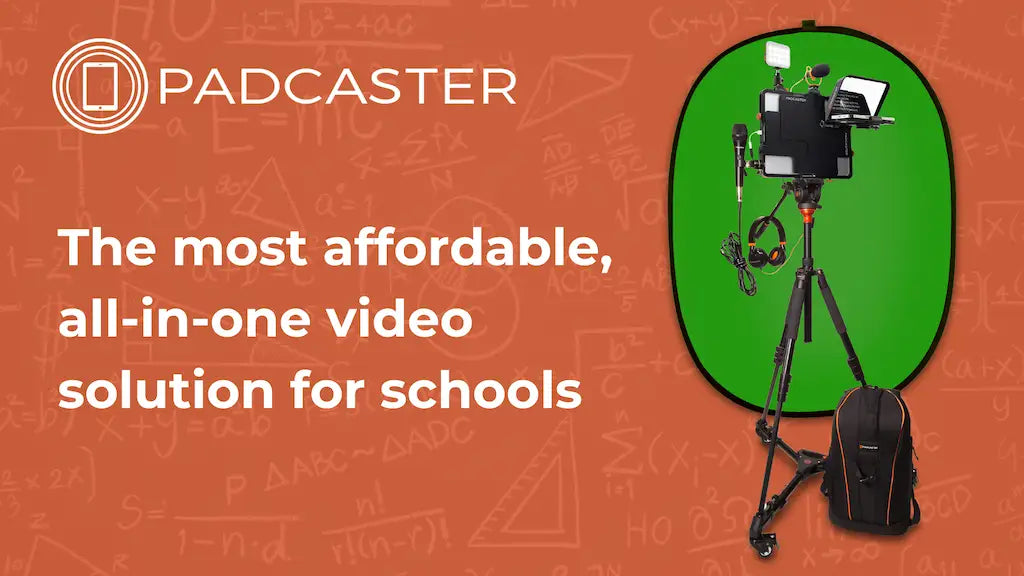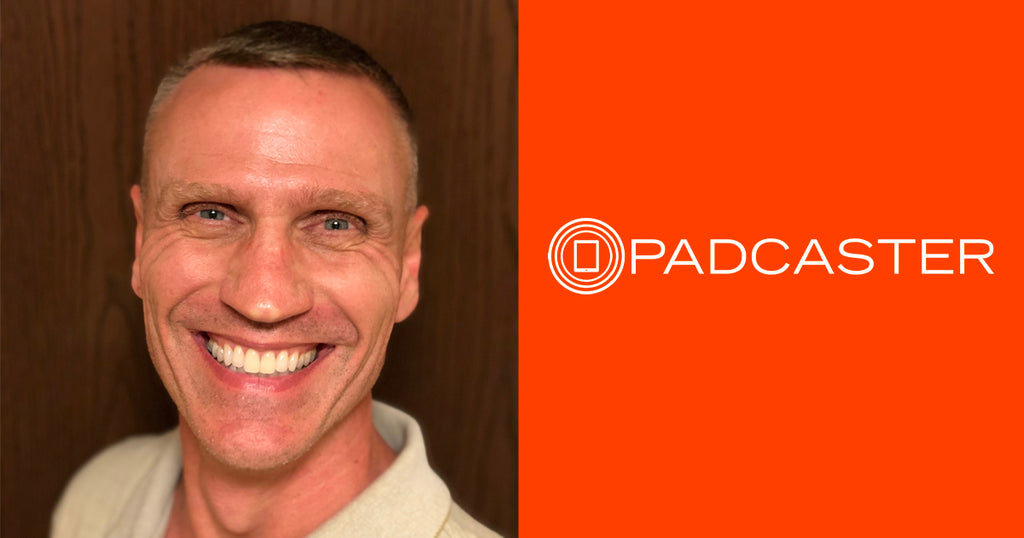
Padcaster was fortunate enough to sit down with dedicated technology educator Ryan Corris of Lakota High School for an interview about his work with the Padcaster Studio and how he’s using video production across multiple subjects. Taking advantage of his own passion for visual learning, Mr. Corris has utilized the Padcaster Studio to create professional development tools for teachers as well as projects that help connect students across grades levels. Read his interview below:
--
Tell us a little background about yourself and how you’ve ended up in your current role?
I am finishing up my 28th year in education. I hold a Bachelor’s Degree in Education from Bowling Green State University and a Master’s Degree in Education from Miami University. When I began teaching, I did not even have an email address...personal or professional. After teaching 5th grade for a few years, I purchased my first computer. It was an Apple LC III with a 20 MB hard drive. Yes, the entire hard drive was 20 MB...not GB! That Apple computer ignited my passion for using technology in education. Initially, it using for myself, which quickly turned into training other teachers, and over time using it with students in class as more computers started showing up in classrooms. Since buying that first computer, I have taught 4th and 5th grade, 8th-grade science, spent a few years as a technology coordinator and taught math and science part-time at a branch campus of Miami University. Due to my love of technology and its uses in education I have spent the last five years as a Digital Learning Specialist evolving into an Innovation Specialist for the Lakota Local School District in Southwest, Ohio.
As an Innovation Specialist, what is your main focus, what are your goals, and who do you primarily work with?
My main focus as an Innovation Specialist is working with teachers and assisting them with integrating technology purposefully, personalizing learning for students, and helping to make sure our students are Future Ready. My responsibilities include creating and offering professional development, modeling lessons in classrooms, planning with teachers, developing engaging activities, assisting students and teachers in our Innovation Hub, and doing my best to offer strong strategies for authentic learning.
Why is integrating technology into learning so important? How does one do it purposely?
Students are growing up in a world filled with technology, but that does not mean they know how to use it for educational purposes. The more experiences they can have with various types of technology through learning processes may give them advantages as they progress in their lives. Before using the Padcasters in our Innovation Hub, most of our students had never created a green screen video or used an actual video editing tool before. Now, on a regular basis students are creating videos that look like they are visiting anywhere in the world (sometimes universe) and cropping segments, adding clip art, including captions and titles, and continuing to come up with new ways to make their videos unique. In regards to the purposeful use of technology, it is important that the tech is supporting the learning and not the focus of the learning. Our students are not just making videos to make videos. They are sharing their knowledge and their learning in creative ways while also working on soft skills, such as planning, collaboration, and time management. A tool is just a tool. What you do with the tool is what makes the difference!
How were you first introduced to Padcaster?
This past January our high school Media Centers evolved into Innovation Hubs with flexible furniture, adjusted spaces, and some new equipment, including the Padcasters. Personally, I had never used a Padcaster before January, but I knew it was something I wanted to learn. After exploring the ins and outs of Padcasters over a few days, a teacher came into the Innovation Hub and decided she wanted her American Sign Language classes to make videos. The ASL classes tend to make several videos throughout the year, but the ability to use green screen and edit the videos would definitely step things up a few notches. So, the Padcasters got broken in quickly at Lakota East High School. Word spread, and the Padcasters became one of the most popular items in the Innovation Hub.
How do you think utilizing video can aid in teaching visual learners?
Well, if YouTube was available when I was in school, maybe my own grades would have been a little better. The ability for students to explore course content with the opportunity to rewatch it, pause it and reflect on it, walk away when frustrated and come back to it later, and learn anywhere at any time is amazing! And that is just consuming videos. The ability for students to create their own videos allows for an outlet of creativity and infinite ways for students to show off their talents, enhance their voice, and share their ideas with the world. If a picture is worth a thousand words, imagine how many words are incorporated into a video. And with these words also comes student voice!
Can you tell us more about your school’s Innovation Hub? How does it work?
Our Innovation Hub is available for students, teachers, classes, meetings, gatherings, after school events, etc. I look at the Innovation Hub as the “Room of Requirement” from the Harry Potter Series. It is there and will be what you need it to be. You can explore French culture using Google Earth on the VR systems, collaborate on a group project, peer critique artwork on the monitors at the collaboration tables, Skype to communicate with an expert or work with other students throughout the district, and create some great videos too. Students stop in to work before, during, and after school for a variety of tasks, projects, meetings, clubs, and studying.
How do you use the Padcaster as a tool for professional development for adults?
It has been a great opportunity for the teachers to learn about the Padcasters right alongside the students. As students increase their own skills they have taught the teachers and as the teachers learn more, they feel more comfortable when helping students and planning future activities and projects. Since the Padcasters are relatively new in our building, we are bouncing around some ideas for professional development, but maybe those ideas are better left for another time.
You mentioned an exciting project you did with an American Sign Language Class. Tell us more about that. What was the most rewarding part of the project?
Our American Sign Language (ASL) classes have been frequent flyers in the Hub with the Padcasters. One of my favorite projects of the ASL students is their song videos. Students chose some children’s songs (ie. days of the week, seasons, colors, and even Baby Shark). Once again, they did not just “make” the videos. The intent was to actually share these videos with elementary students in the district. The elementary teachers would decide when their students would need a brain break and share the videos with their classes. The first part of the videos teaches the signs that are used in the songs, and then the song is played. The elementary students can watch the high school students perform the signs during the songs and follow along. The videos were such a hit with the elementary classes that the high school students began doing some live performances via Skype. This gave the elementary students an opportunity to interact with some of the people they had been watching in the videos as well as ask questions and learn new signs that they wanted to learn.
I am having a difficult time finding only one rewarding thing about this project, so I am going to share three. First, it was watching the high school students create the videos using the Padcasters and seeing how much fun they were having. They were working on something for a truly authentic audience and it was evident that they were enjoying the project. Second, the technology was being learned, but it was NOT the focus of the learning. Every ASL student in the school knows how to use the Padcasters, but the planning, creating, deciding which signs to teach and use, and how to present to their audience was key to the learning. The third rewarding part of this project has to be the excited faces and engagement of the elementary students during the Skype sessions after they had watched some of the videos first. I have a feeling some of these young elementary students are already looking forward to some of the fun projects that they will be able to experience when they get to high school.
What were some of the other projects you’ve worked on with Padcaster? Which ones had the biggest impacts? Why do you think this is?
I would have a difficult time saying that one of these was more impactful than another project. Being from so many different content areas, so many different concepts were being explored. All of the activities were impactful because they were authentic and purposeful. I would say that there was some impact in the overlap of the students though. Since all of the students in ASL classes have had experience with the Padcasters, we started to see some of the ASL students come to the Hub for projects in other classes as well. They were able to help other students in and out of their own groups while students that had not experienced the Padcasters yet began their experiences.
Some Examples:
- Economics - Students worked in groups to create a product that would solve a problem. Students created videos using the Padcaster that introduced and marketed the product.
- Latin - While students had some choices on how to present, many of the groups shared videos of their retellings created using the Padcasters.
- ASL - Students created videos to show why they feel signing is so important. #whyWEsign (The W and E are both capitalized to represent our West and East high schools.) Students studied either a famous or historical deaf person. Videos were created using various backgrounds within each video. Students then customized a Google Drawings template to make a Time Magazine cover of their individual. The magazine covers included QR codes. The Time Magazine covers were posted in the auxiliary gym where a gallery walk took place for staff and students to learn about the famous and historical deaf individuals. A topic that some of the ASL students sign about was driver’s ed. Instead of just creating videos of the students telling driver’s ed stories, a driver’s license template was created. Student could adjust some of the details, but where the photo would normally go on the driver’s license was the student’s video where they signed their story.
- Science - As the culminating activity for the Evolution Unit students presented a passion project. In this passion project, they explored the evolutionary history of an organism of their choice. To finalize the learning, a product of choice was created and shared with their peers on the last day of the quarter. A popular choice among students was using the Padcasters to create a video. Throughout the year, a chemistry teacher has run a CSI type investigation of the untimely death of an individual. The students have gained knowledge and insight throughout the year. Now it is time for the students to attempt to solve the murder based of evidence they have collected. They will be creating videos using the Padcasters to state their case and attempt to solve the mystery.
You mentioned having teachers create videos detailing the subjects of their courses, how did this project turn out?
This year, a task for our teachers was to create videos to introduce each content area course. The videos were used for students to get a preview of courses prior to signing up for next year’s schedules. Several teachers decided to use the Padcasters and green screens to create their course videos. This was great for the teachers because it not only gave them the stage to share their courses but to also personalize their message and give the students an opportunity to get to know the teachers as well.
- ESL - Our ESL students had a cultural fair to help people at our school understand their cultures better. This was part of an extended Project-Based Learning (PBL) project. At the cultural fair, the ESL students set up a “photo booth” using the Padcasters. Backgrounds were chosen from specific countries. People that attended the cultural fair could have their picture taken as though they were visiting that country. Some people even dressed up in clothing to make the scene more realistic.
- English - Students were studying the Renaissance in English class. A culminating project was to have students use the Padcasters to create videos to show their knowledge of the Time Period.
- Photography - Students integrated their own photographs of personal objects as backgrounds. Using the Padcasters and green screens, they explored scale and added themselves to their own images making their personal items larger than life.
What do you think is the most valuable lesson students can learn from creating their own videos?
Many of the students that come to the Hub to create videos have never used a video editor like Do Ink or WeVideo. Now, a good percentage of students in our building of over 2,000 have experience with using a video editor during or after recording with the Padcasters. You may say I am contradicting myself because this statement is all about the tools. However, because they used these “tools”, students have now looked at the content they are learning differently, hopefully, dove a little deeper into the content to find out what was most important to include in the videos, problem solved, collaborated with others, managed their time, evaluated their project to see what needed to be kept or redone, and so many other soft skills that seem to be in such high demand from universities and businesses these days.
What upcoming projects are you planning with students or teachers?
We are coming to the end of our school year, but the Padcasters are basically in use up to the last days of the school year. So, we are not necessarily working on new projects for this year, but the teachers that have used the Padcasters with their students are thinking about how the projects can be tweaked to make them better for next year as well as brainstorming about how the Padcasters can be used to enhance learning for other parts of their courses.
What is the biggest piece of advice you can give to other educators who are teaching media production?
I am a big proponent of giving students some guidelines and requirements and letting the creative juices flow. Don’t tell them exactly what should be in the video and how it should look. Even give the student the opportunity to choose what type of genre their video will be. Using the exact same topic, to begin with, one group might make a documentary, another creates a newscast, while another group might even make a short sitcom. Allow as much choice as possible, include your non-negotiables, and let them go!
Padcaster transforms your iPad or smartphone into an all-in-one mobile production studio so you can create professional-quality videos from your home or anywhere else. Whether it’s for distance learning, telecommuting, remote broadcasting or livestreaming -- Padcaster will help you produce high-quality content wherever you are. If you have had an event that has been moved online due to COVID-19 such as a wedding, religious service, graduation, or ‘gathering’ of any kind, Padcaster wants to help you! Fill out the form below to get in touch or set up a free video consultation with a Padcaster representative here.Need More Information?
Fill out the form here to get in touch with a member of the Padcaster Team.